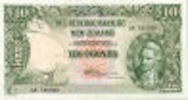The Dutch navigator, Abel Tasman, discovered New Zealand in 1642. Captain Cook claimed the islands for Britain during his visits of 1769 and 1777, but colonization didn't begin until the nineteenth century. New Zealand became a separate British colony on May 3, 1841 under the Waitangi Treaty between the native Maori and British settlers. It became the Dominion of New Zealand on September 26, 1907.
Foreign coins circulated in New Zealand during the nineteenth century, and in 1850 the British Pound Sterling was declared its official legal tender. However, because of a shortage of coins, hundreds of private tokens were issued during the last half of the nineteenth century. British and Australian coins circulated until 1933 when New Zealand issued its first coins.
New Zealand introduced the New Zealand Pound (NZP) at par with the British Pound Sterling. A currency board, established on November 25, 1847, issued banknotes between 1850 and 1856 when banks began issuing banknotes. Six private banks (Bank of New Zealand, National Bank of New Zealand, Commercial Bank of Australia, Union Bank of Australia, Bank of New South Wales) issued banknotes until 1934. The Reserve Bank of New Zealand, created by Act of November 27, 1933 became the sole issuing authority in 1934. The pound was divisible into 20 Shillings or 240 Pence, and the Dollar is divisible into 100 Cents.
Niue, or Savage Island, was discovered in 1774 by Captain Cook. Niue became a British protectorate in 1900 and was annexed to New Zealand as part of the Cook Islands on June 11, 1901. They were separated from the Cook Islands in 1904 and became an associated state of New Zealand on October 19, 1974.
Tokelau (known as the Union Group of Islands) became a British protectorate in 1889 and became part of the British colony of the Gilbert and Ellice Islands on February 29, 1916. The Union Group was renamed the Tokelau Islands in 1946, became attached to New Zealand in 1948.
Niue and Tokelau use the New Zealand Dollar, and they have issued coins for numismatic but not for circulation purposes. The New Zealand Dollar is also used on Pitcairn Island, the Cook Islands, and Ross dependency. Pitcairn Island has issued some coins for numismatic purposes, but none for general circulation.


